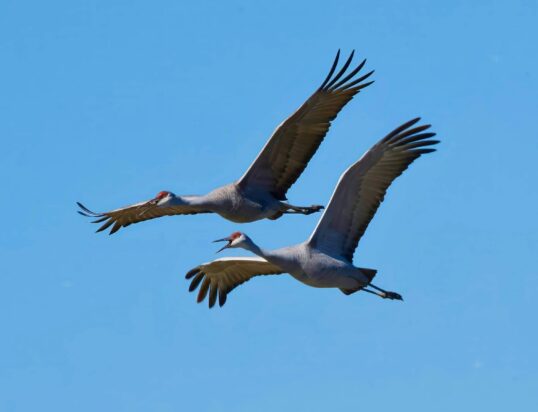Garoo-oo-a-a-a. The call of the sandhill crane always makes me search the sky. My fascination began in my 30s, when my husband and I joined the annual Sandhill Crane Count. We rose at 4 a.m., brewed a thermos of coffee, and set out to meet park coordinator Ed O’Brien and others in a wetland near Briggsville. Equipped with record sheets, each of us was assigned a territory and asked to note when we heard a crane’s guard call or a unison—or mating—call.
On that magical morning, as the sun broke through the fog, I witnessed a pair of cranes dancing. Their mighty wings lifted them effortlessly as they seemed to celebrate the day.
I’m not the only crane admirer. Dell’s resident, Debbie Kinder, delights in a pair returning to the stream on her property every spring. They’ve been wintering and entertaining her for about five years. Once she watched a crane stab a mouse, toss it in the air, and swallow it whole.
In Oxford, Jane Govoni has watched the same pair, Izzy and Icabod, return year after year. They’ve become such a fixture that her yoga students anticipate the cranes joining their class. Each checks on the other’s poses. If Jane flaps her arms and bends her head, the cranes come so close she could touch them. Sometimes they toss a stick into the air, as if wanting to play. Jane misses them when they fly south and eagerly awaits their spring return.
Marquette County has more nesting pairs than any other Wisconsin county, as Briggsville resident Jim Brancel knows. The Crane Foundation regularly visits his fields to capture and study them. They feed the birds sedative-laced corn, tag them, and draw blood for DNA analysis. Through their analysis, they found that cranes often return to the same site. Even more astonishing, most live only 15–20 years in the wild, yet one male made it to 33—with three mates along the way. Discoveries like that spark even more questions.
Jim mentioned that the foundation names newly hatched cranes after landowners, so there is both a Jim Brancel crane and one named for his mother, Betty. Since Betty has passed, Jim was especially delighted four years ago when his spotting scope revealed that “Betty” the crane lingered in front of his house for a long while.
With their wide range, from the wetlands of North America to the plains of Siberia, and their migratory flights often at great heights, many cultures view cranes as intermediaries between earth and sky, as well as between life and death. Jim recalls a wonderfully chilling event that supports this: the 1991 funeral of wildlife artist Owen Gromme.
Gromme was deeply involved in conservation, helped establish the International Crane Foundation (ICF) in Baraboo, and painted birds with reverence. As if in acknowledgment, various birds appeared during his celebration of life. Soon after the priest began his reading, a flock of tundra swans flew toward them, their voices resounding. A hush fell over the crowd, and all stood respectfully. Moments later, a flock of cranes swooped over the Briggsville marsh, followed by a V-formation of honking Canadian geese. Jim saw it as a poignant tribute—a winged escort into the next world.
Stories like Jim’s remind me why cranes inspire awe across cultures. If, like me, you’re drawn to cranes, join me at Baraboo’s Great Midwest Crane Fest, November 15–16: https://savingcranes.org. I hope to see you there. Garoo-oo-a-a-a.

